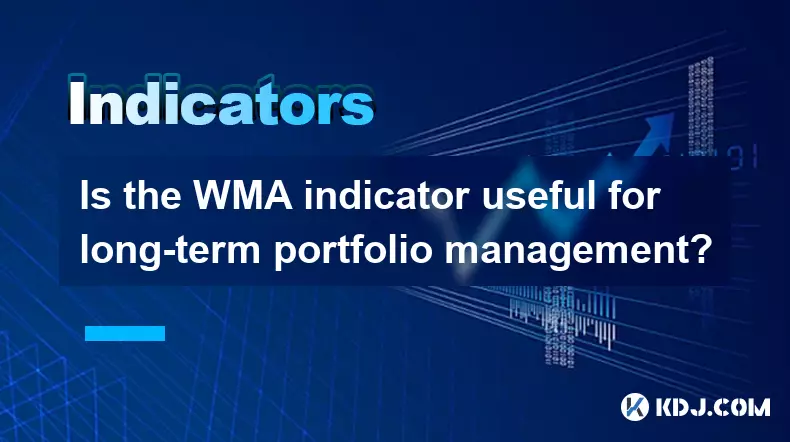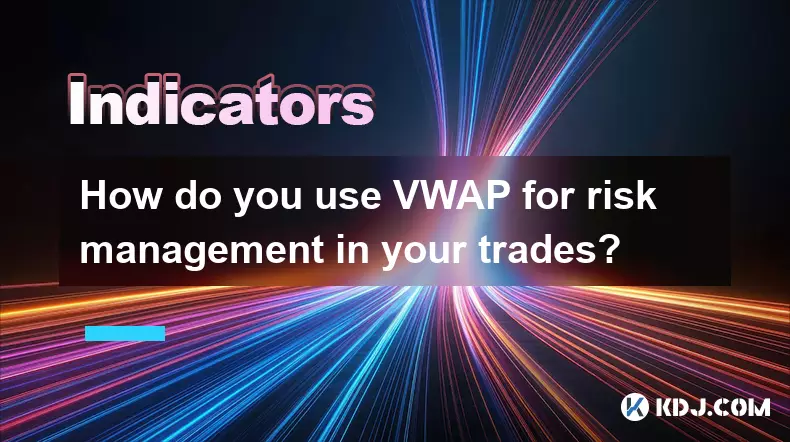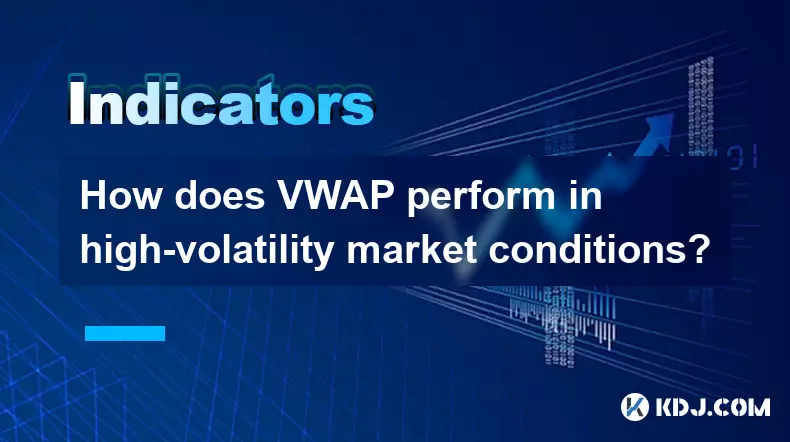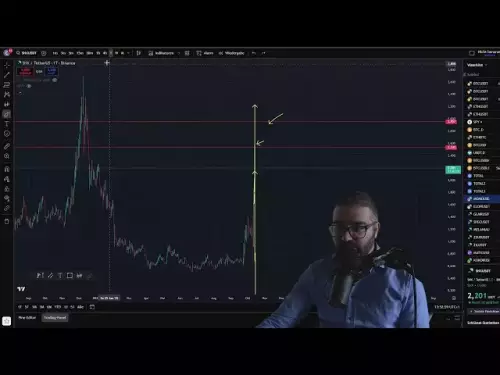-
 bitcoin
bitcoin $115692.075601 USD
5.13% -
 ethereum
ethereum $4162.931611 USD
11.68% -
 bnb
bnb $1310.063287 USD
17.56% -
 tether
tether $1.000983 USD
0.00% -
 xrp
xrp $2.534505 USD
8.16% -
 solana
solana $198.235737 USD
13.49% -
 usd-coin
usd-coin $1.000236 USD
0.02% -
 dogecoin
dogecoin $0.207352 USD
12.89% -
 tron
tron $0.323043 USD
3.62% -
 cardano
cardano $0.701559 USD
11.88% -
 hyperliquid
hyperliquid $39.924597 USD
8.30% -
 chainlink
chainlink $18.934457 USD
11.56% -
 ethena-usde
ethena-usde $1.000552 USD
0.02% -
 stellar
stellar $0.340575 USD
7.05% -
 bitcoin-cash
bitcoin-cash $545.011757 USD
8.86%
Is the WMA indicator useful for long-term portfolio management?
The Weighted Moving Average (WMA) enhances crypto trading by prioritizing recent prices, offering timely signals for trend shifts in 24/7 markets.
Oct 11, 2025 at 08:54 am

Understanding the WMA in Cryptocurrency Markets
1. The Weighted Moving Average (WMA) assigns greater importance to recent price data, making it more responsive to new information compared to simple moving averages. In fast-moving environments like cryptocurrency trading, this responsiveness can help investors detect shifts in momentum earlier. Because digital asset prices often experience sharp swings due to news, regulatory changes, or macroeconomic factors, tools that react quickly are highly valued.
2. Unlike traditional financial markets, crypto operates 24/7, leading to continuous price discovery without daily market closures. This constant activity increases the relevance of indicators like the WMA, which can adapt rapidly to evolving trends. Long-term portfolio managers may use WMA crossovers—such as when a short-term WMA crosses above a long-term one—as signals to adjust allocations or rebalance holdings.
3. The mathematical structure of the WMA gives higher multipliers to newer data points. For instance, in a 5-day WMA, today’s price is multiplied by 5, yesterday’s by 4, and so on. This design makes the indicator particularly sensitive during periods of high volatility, common in assets like Bitcoin and Ethereum. As a result, it can serve as an early warning system for potential trend reversals.
Integration with Long-Term Investment Strategies
1. While many associate technical indicators with short-term trading, the WMA can support strategic decision-making over extended timeframes. Portfolio managers might apply longer WMA periods—such as 50-week or 100-week versions—to filter out noise and focus on major directional movements. These smoothed trends help identify structural bull or bear phases in the crypto market.
2. When combined with fundamental analysis—such as network activity, developer engagement, or adoption metrics—the WMA adds a layer of timing precision. For example, entering a position when the 200-week WMA begins sloping upward and coincides with increased on-chain transaction volume could signal a robust long-term opportunity.
3. Some institutional-grade crypto funds incorporate WMAs into algorithmic rebalancing models. These systems automatically adjust exposure based on whether the current price is above or below key WMA thresholds. Such rules-based approaches reduce emotional bias and enforce discipline, especially during extreme market conditions.
Risks and Limitations in Practice
1. Despite its advantages, the WMA is not immune to false signals. During sideways or choppy markets, frequent crossovers may lead to whipsaws, causing unnecessary trades and increased transaction costs. This issue is amplified in smaller-cap altcoins, where price manipulation and low liquidity distort technical patterns.
2. Relying solely on the WMA neglects broader macro factors influencing crypto valuations. Regulatory crackdowns, technological failures, or shifts in monetary policy can override any technical signal. Therefore, using the WMA in isolation risks creating blind spots in portfolio management.
3. Backtesting WMA-based strategies requires careful consideration of historical market structure. Early crypto markets behaved differently than today’s more mature ecosystem, meaning past performance may not reliably predict future outcomes. Overfitting models to specific cycles—like the 2017 or 2021 rallies—can produce misleading confidence in the indicator’s effectiveness.
Frequently Asked Questions
What is the difference between WMA and EMA in crypto trading?The WMA applies linear weights to price data, while the Exponential Moving Average (EMA) uses a smoothing factor that gives exponentially decreasing weight to older prices. The EMA tends to react even faster to recent price changes, making it more volatile. In turbulent crypto markets, traders must choose based on their sensitivity preference.
Can WMA be used effectively for altcoin portfolios?Yes, but with caution. Altcoins often exhibit erratic price behavior due to speculative sentiment and lower trading volumes. Applying longer WMA periods can mitigate some noise, yet combining it with volume analysis or on-chain metrics improves reliability. Not all altcoins respond well to technical indicators alone.
How do I configure WMA settings for long-term crypto investing?For long-term horizons, weekly or monthly charts are preferable. Common configurations include the 50-week and 200-week WMA. Crossing above the 200-week WMA might indicate a long-term bullish shift, especially if confirmed by rising trading volume and improving fundamentals.
Disclaimer:info@kdj.com
The information provided is not trading advice. kdj.com does not assume any responsibility for any investments made based on the information provided in this article. Cryptocurrencies are highly volatile and it is highly recommended that you invest with caution after thorough research!
If you believe that the content used on this website infringes your copyright, please contact us immediately (info@kdj.com) and we will delete it promptly.
- XRP Price Prediction: Weekend Rollercoaster or Rally?
- 2025-10-12 08:45:16
- Bittensor (TAO): Super Bullish Signals Point to Potential 2x Rally
- 2025-10-11 10:25:12
- Silver Price Correction: Navigating the Dip & Identifying Key SEO Keywords
- 2025-10-11 10:25:12
- Decoding Crypto Trends: Bittensor's Bull Run, Cardano's Dip, and LivLive's Presale Buzz in 'Uptober 2025'
- 2025-10-12 08:45:16
- MoonBull: The Crypto Meme Coin Promising 1000x Gains?
- 2025-10-11 10:30:01
- Crypto Payroll Revolution: Stablecoins, Altcoins, and the Future of Salary Payments
- 2025-10-11 10:30:01
Related knowledge

What's the main difference between VWAP and TWAP?
Oct 12,2025 at 11:54am
Understanding VWAP and Its Role in Crypto Trading1. Volume Weighted Average Price (VWAP) is a trading benchmark that calculates the average price of a...

How do you identify exhaustion moves using VWAP and its bands?
Oct 12,2025 at 08:00am
Understanding the Role of Decentralized Exchanges in Crypto Trading1. Decentralized exchanges (DEXs) operate without a central authority, allowing use...

What are the main advantages of using VWAP over EMA?
Oct 11,2025 at 02:18am
Main Advantages of Using VWAP Over EMA1. Volume-Weighted Average Price (VWAP) incorporates trading volume into its calculation, offering a more accura...

How do you use VWAP on different chart types like Heikin Ashi?
Oct 11,2025 at 05:01pm
Understanding VWAP in the Context of Heikin Ashi Charts1. The Volume Weighted Average Price (VWAP) is a powerful analytical tool commonly used by trad...

How do you use VWAP for risk management in your trades?
Oct 11,2025 at 02:54am
Understanding VWAP as a Dynamic Benchmark1. The Volume Weighted Average Price (VWAP) serves as a crucial reference point in intraday trading by reflec...

How does VWAP perform in high-volatility market conditions?
Oct 10,2025 at 08:00pm
Understanding VWAP in Turbulent Market Phases1. Volume-Weighted Average Price (VWAP) serves as a benchmark for institutional traders aiming to assess ...

What's the main difference between VWAP and TWAP?
Oct 12,2025 at 11:54am
Understanding VWAP and Its Role in Crypto Trading1. Volume Weighted Average Price (VWAP) is a trading benchmark that calculates the average price of a...

How do you identify exhaustion moves using VWAP and its bands?
Oct 12,2025 at 08:00am
Understanding the Role of Decentralized Exchanges in Crypto Trading1. Decentralized exchanges (DEXs) operate without a central authority, allowing use...

What are the main advantages of using VWAP over EMA?
Oct 11,2025 at 02:18am
Main Advantages of Using VWAP Over EMA1. Volume-Weighted Average Price (VWAP) incorporates trading volume into its calculation, offering a more accura...

How do you use VWAP on different chart types like Heikin Ashi?
Oct 11,2025 at 05:01pm
Understanding VWAP in the Context of Heikin Ashi Charts1. The Volume Weighted Average Price (VWAP) is a powerful analytical tool commonly used by trad...

How do you use VWAP for risk management in your trades?
Oct 11,2025 at 02:54am
Understanding VWAP as a Dynamic Benchmark1. The Volume Weighted Average Price (VWAP) serves as a crucial reference point in intraday trading by reflec...

How does VWAP perform in high-volatility market conditions?
Oct 10,2025 at 08:00pm
Understanding VWAP in Turbulent Market Phases1. Volume-Weighted Average Price (VWAP) serves as a benchmark for institutional traders aiming to assess ...
See all articles










































































